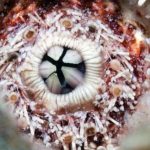Paper, Ground sampler based on Sea Urchin Jaws
This research paper explores the possibility of using design ideas taken from the sea urchins’ mouth to build ground biopsy harvesters. Called Aristotle’s lantern, the mouth of sea urchins are composed of five calcium carbonate teeth that are arranged in a dome-like foundation. This shape that has the teeth protrude outwards when open and vice versa when closed, works to effectively chew and scrape against the rocky ocean floor in which they reside in. Due to the unique and powerful ability of sea urchins’ mouth/teeth, humans have discovered a new source of bio-inspiration that has since led to the creation of a sediment sampler. The rest of this article contains the basic procedures in going further into researching the sea urchins’ mouths, the bio-inspired design, other biological explorations, and lastly results from these experiments.
Learn about our two Decals!
 Click here to find out more about our Fall Bioinspired Design Decal and our Spring Bioinspired Design in Action Decal – ALL MAJORS are welcome.
Click here to find out more about our Fall Bioinspired Design Decal and our Spring Bioinspired Design in Action Decal – ALL MAJORS are welcome.Berkeley BioDesign Community
 Click here to learn about the BioD: Bio-Inspired Design @ Berkeley student organization or here to signup for more info.
Click here to learn about the BioD: Bio-Inspired Design @ Berkeley student organization or here to signup for more info.Search
Student Login




I imagine that the neurological circuits underlying these processes are governed by both 2d spacing maps with their brains as…
to reduce the impact of car accidents, it may be possible to study the force diverting physics of cockroaches to…
you see this type of head-bobbing stability in many avian creatures related to pigeons like chickens. the head ability to…
not like they taught horses how to run! this is an example of convergent evolution where both sea creatures and…
The brain functions in a similar way with neuronal connections. our brains are able to utilize the multiplicity of connections…